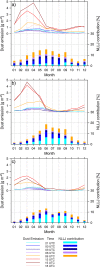Climatology of nocturnal low-level jets over North Africa and implications for modeling mineral dust emission
- PMID: 25893154
- PMCID: PMC4394707
- DOI: 10.1002/jgrd.50394
Climatology of nocturnal low-level jets over North Africa and implications for modeling mineral dust emission
Abstract
[1] This study presents the first climatology for the dust emission amount associated with Nocturnal Low-Level Jets (NLLJs) in North Africa. These wind speed maxima near the top of the nocturnal boundary layer can generate near-surface peak winds due to shear-driven turbulence in the course of the night and the NLLJ breakdown during the following morning. The associated increase in the near-surface wind speed is a driver for mineral dust emission. A new detection algorithm for NLLJs is presented and used for a statistical assessment of NLLJs in 32 years of ERA-Interim reanalysis from the European Centre for Medium-Range Weather Forecasts. NLLJs occur in 29% of the nights in the annual and spatial mean. The NLLJ climatology shows a distinct annual cycle with marked regional differences. Maxima of up to 80% NLLJ frequency are found where low-level baroclinicity and orographic channels cause favorable conditions, e.g., over the Bodélé Depression, Chad, for November-February and along the West Saharan and Mauritanian coast for April-September. Downward mixing of NLLJ momentum to the surface causes 15% of mineral dust emission in the annual and spatial mean and can be associated with up to 60% of the total dust amount in specific areas, e.g., the Bodélé Depression and south of the Hoggar-Tibesti Channel. The sharp diurnal cycle underlines the importance of using wind speed information with high temporal resolution as driving fields for dust emission models. Citation: Fiedler, S., K. Schepanski, B. Heinold, P. Knippertz, and I. Tegen (2013), Climatology of nocturnal low-level jets over North Africa and implications for modeling mineral dust emission, J. Geophys. Res. Atmos., 118, 6100-6121, doi:10.1002/jgrd.50394.
Keywords: ERA-Interim reanalysis; Harmattan; Saharan heat low; diurnal cycle; dust emission; nocturnal low-level jet.
Figures


















References
-
- Abdou K, Parker D J, Brooks B, Kalthoff N, Lebel T. The diurnal cycle of lower boundary-layer wind in the West African monsoon. Quart. J. Roy. Meteor. Soc. 2010;136(s1):66–76. doi: 10.1002/qj.536. - DOI
-
- Alpert P, Neeman B U, Shayel Y. Climatological analysis of Mediterranean cyclones using ECMWF data. Tellus A. 1990;42:65–77. doi: 10.1034/j.1600-0870.1990.00007.x. - DOI
-
- Baas P, Bosveld F, Baltink H K. A climatology of nocturnal low-level jets at Cabauw. J. Appl. Meteor. and Climat. 2009;48:1627–1642.
-
- Bain C L, Parker D J, Taylor C M, Kergoat L, Guichard F. Observations of the nocturnal boundary layer associated with the West African monsoon. Mon. Wea. Rev. 2010;138(8):3142–3156. doi: 10.1175/2010MWR3287.1. - DOI
-
- Banta R, Pichugina Y, Newsom R. Relationship between low-level jet properties and turbulence kinetic energy in the nocturnal stable boundary layer. J. Atmos. Sci. 2003;60(20):2549–2555. doi: 10.1175/1520-0469(2003)060<2549:RBLJPA>2.0.CO;2. - DOI
LinkOut - more resources
Full Text Sources
Other Literature Sources
Miscellaneous
